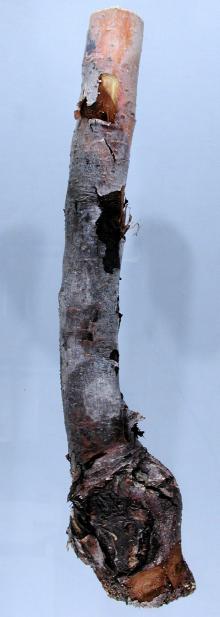See:
Peach (Prunus persica) - Cytospora Canker
Cause Cytospora canker, also known as Leucostoma canker or Valsa canker, has long been reported to affect both pome and stone fruits in the PNW including British Columbia, especially after severe winters. Cytospora spp. associated with fruit tree cankers in BC include C. parasitica, C. populicola and C. sorbicola. Alone they are weakly pathogenic on apple but these are vigorous wound invaders (including wounds from sunscald and winter injury) that ramify throughout the bark and cambium and to a lesser extent the tree's structural wood. Cankers often develop around pruning wounds. Various ornamental shrubs and trees are susceptible as well. All these hosts can provide overwintering sites. Cytospora fungi do not destroy the tree's structural strength, but other fungi can invade the infection sites and cause wood rotting.
Overwintering is in infected stems and stem debris on the ground. These fungi have a wide host range and can infect virtually all stone fruit and pome fruit trees. Conidia are produced in cherry and peach orchards in eastern Washington throughout the year and the inoculum concentration is highest during the spring and summer. Over-the-canopy and under-tree sprinkler irrigation can promote sporulation and disperse conidia.
Symptoms The first evidence of infection usually is dead twigs. Leaves above stem infections droop and discolor through shades of green to various shades of brown; they remain attached, sometimes through the winter. These "flags" are caused by stem invasions that have raised cankers that girdle or nearly girdle the stem immediately below the flag. Cankers are small at first but slowly enlarge elliptically; sometimes they streak rapidly up and down the stem without immediate girdling. In late season, a callus forms at canker margins, and fungal activity resumes in spring. The bark in the center of cankers becomes rough and scaly. Canker surfaces develop raised pinhead-size pimples (pycnidia) in the bark, but these may not be readily visible. Amber to orange, hair-like spore tendrils extrude from the pycnidia in humid weather. These break off easily and can be blown about, tracked around by insects, and splashed by rain. In very wet weather, an amber spore droplet instead of the spore hair may form on the pycnidia.
Cultural control
- Remove dead branches, cutting well below (at least 1 ft) any visible discoloration in the bark.
- Do not establish new orchards close to or downwind from badly diseased orchards.
- Treetop or other hedgerow pruning and overhead irrigation are not advised where the disease is a problem.
- Take special care to avoid wounding trees during the growing season. Tractors and sprayers commonly inflict such wounds, as do shakers, ladders, and pickers' feet.
- Train trees properly.
- Avoid rodent injury.
- Avoid excessive nitrogen fertilization, nitrogen applications late in the growing season, or late-season cultivation or irrigation.
- Paint the southwest side of tree trunks with white latex paint to avoid winter injury.
- Surgically remove cankers from trunks and scaffold limbs in summer.
Chemical control The use of latex paint, Captan and/or Topsin was shown to be effective wound protectants prior to infection in Colorado. Latex paint, however, did not result in long term effective control. Lime sulfur gave variable results. Use of these materials after pruning or winter injury may be helpful. Use of copper-based fungicides was ineffective.
References Úrbez-Torres, J. R., Boulé, J., Walker, M., Hrycan, J. and O'Gorman, D. T. 2024. Identification of fungal pathogens causing fruit tree dieback in British Columbia. Canadian Journal of Plant Pathology, 46:89-105.




